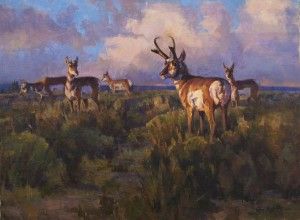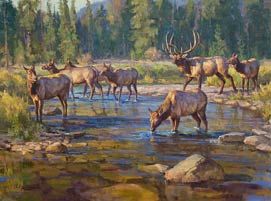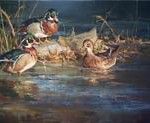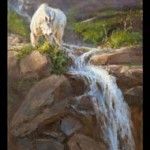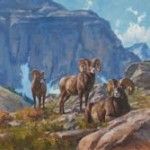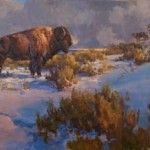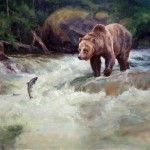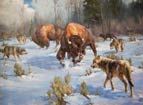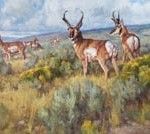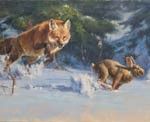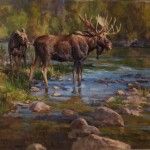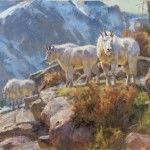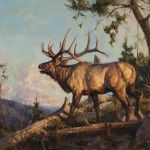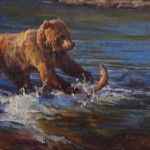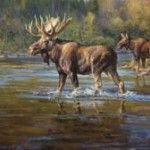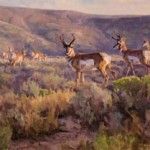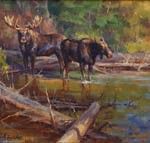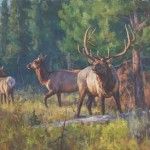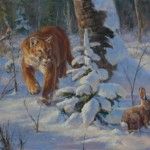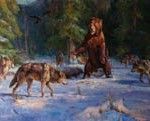Utah painter Chad Poppleton portrays wild animals with the accuracy they deserve
By Gussie Fauntleroy
When he stands at one of the large windows in the studio his father built, wildlife painter Chad Poppleton can see back in time as well as out across northern Utah’s broad Cache Valley. Poppleton spent hours as a boy in the bluff-top studio, drawing and painting and watching his father do the same. When he wasn’t pursuing the brush, he was out exploring the nearby Little Bear River, hunting and fishing in the surrounding mountains, or doing chores on his family’s ranch and farm.
Gazing further across the generations, the 34-year-old artist sees his ancestors on this same piece of land. He imagines them, as settlers in the mid-1800s, building forts, establishing farms, and making homes in the spreading valley, whose name recalls a time when mountain men cached their beaver pelts and gathered there to trade.
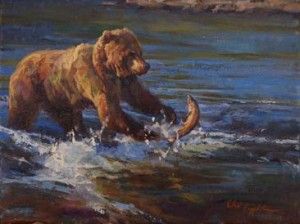
Chad Poppleton | Slippery when wet, oil, 9 x 12.
With a generations-long connection to both the ranch and the mountains and streams, young Chad was torn in two directions as a boy: He wanted to grow up to be a mountain man, honing an intimate understanding of the ways of the wild. And he wanted to be a rancher, working daily with horses and cattle on familiar ancestral land. Now, to an extent, he does both.
Known for his skillful portrayal of wildlife in natural settings, Poppleton has built a life that combines the things he loves. On a ranch a couple of miles from his childhood home—where his parents still live and the studio sits on a bluff—he rises early to help his wife, Amy, get their five children ready for the day. When it’s not alfalfa haying season, he puts in “office hours” (9 to 5) at his easel, followed by farm chores and family time. Or he heads into the mountains for several days, pack horses carrying all his sketching, photographing, hunting, fishing, and camping supplies. Or he travels to shows to appreciate other art or exhibit his own. “If somebody is bored with life,” he chuckles, “he should get a ranch, have a family, and be an artist.”
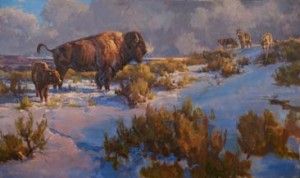
Chad Poppleton | All on the Line, oil, 28 x 42.
For as long as he can remember, Poppleton has been immersed in the intertwining realms of art and the natural world. While his father, Craig Poppleton, is a custom-home builder rather than a painter these days, Chad describes him as “one of the few people I know who is artistic in everything he does.” That was the case as the younger Poppleton was growing up, as well. On family camping trips his father would constantly encourage his children to notice things like the colors of snow against gray rocks, multiple hues in clouds, or the curve of a meandering stream. “He pointed things out not so much in counsel but in appreciation of the world. As a kid, you pick up on that,” Poppleton reflects, and then smiles. “I probably drove my friends crazy, always asking them to stop the car and pointing things out. Now my wife and kids have to tolerate that.”
Even as a young boy, Poppleton felt intensely compelled to draw and paint the things he loved: wildlife, cowboys, horses, and mountain men. He poured over his parents’ issues of Southwest Art, as well as stacks of old copies of Sports Afield and Outdoor Life, admiring wildlife illustrations by Bob Kuhn and other masters of the genre. Doodles of deer and elk found their way onto math tests and English papers, and the only classes in which Chad remembers excelling were art classes. His dubious relationship with academics is reflected in a wry summation from that time: “If I’m not in trouble, I’m in art.”
After high school Poppleton served on a church mission in Arizona, where he took note of art collections in the homes of church members. He remembers being especially struck by one couple’s deep sense of appreciation for the painting over their mantel. “That’s when it hit me, that this is what I really need to do,” he recalls. He told his wife he was going to school for art. At Utah State University he earned a bachelor of fine art degree in illustration and painted every night while also working in construction. A few years later, through “determination, faith, and sweat,” as he puts it, he was able to shift into full-time art.
Aside from learning to see with an artist’s eye, one of the key lessons Poppleton gained from his father was the importance of incorporating stories into his work. To do that with wildlife requires understanding an animal inside and out, from its bones and muscles to the nuances of its habits, movements, and what can be read in its stance. To do that requires being out there, spending hours and days in the animal’s habitat, watching, photographing, sketching, and taking mental notes.
Poppleton’s skill in this realm was reflected recently in a friend’s comment, which the artist took as an honored compliment: “He said when he looks at my animals, it’s almost as if he can understand their thoughts and motives and what their next actions will be,” he relates, adding, “Every piece I paint is an experience I’ve had in the wild. It has to come from me and from my heart. Then I relay those experiences on canvas.”
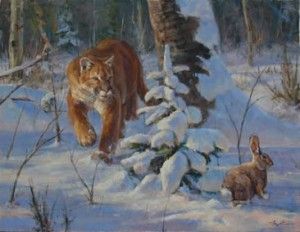
Chad Poppleton | Tie goes to the runner, oil.
COOLIN’ DOWN was inspired by an evening encounter in Colorado’s Rocky Mountain National Park. As he and an artist friend watched, a group of elk emerged from the pines, where they had been resting in the heat of the day, and wandered down to a river to drink. With evening light slanting across their sides, a half-dozen female elk were standing in the river as a large bull elk came up behind them, “making sure his harem was accounted for,” Poppleton explains. “He was bugling and letting everyone know who was boss, and we were just about 50 yards away—we really got to read those animals.”
Poppleton’s friends describe him as “big-game savvy,” a trait acquired not only through the pursuit of wildlife during hunting, sketching, and photographing over the years but also from a lifetime of working with large animals on the ranch. “You have to be able to gauge an animal’s attitude—when to get close and when not to get close,” he points out. Still, he has had a few too-close-for-comfort encounters, like the time a female moose charged another cow competing for the attention of a male. The fleeing moose had only one route for escape—just feet from where the artist stood.
Sometimes the tension of a scene is contained in the moments of stillness before action explodes. Such is the case with ALL ON THE LINE, in which a mother bison, tail raised, breath frosty in the winter air, stands unmoving between her calf and a pack of wolves slinking toward them down a small hill. Roiling dark clouds and sharp bands of sunset light accentuate the drama, the outcome intentionally left unknown. The idea for the painting came while Poppleton was in the Grand Teton mountains watching wolves who were peering over the side of a bluff, eyeing a buffalo herd. The compelling image of an agitated cow with her calf remained in the artist’s mind for several years. When he set out to create the painting, he decided to include only the cow and calf, as if separated from the herd. “I’d like to do more with the interplay of predator and prey species,” he notes.
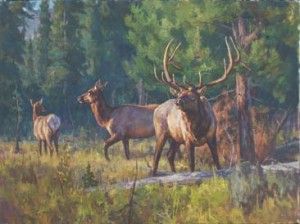
Chad Poppleton | The romance of September, oil, 34 x 46.
While epic drama is a natural part of the animal world, most of Poppleton’s wildlife experiences are more serene. In the foothills of Wyoming’s Wind River Mountains last fall, the last light of day touched a small group of antelope grazing in the sagebrush. “The buck lifted his head and watched me from the corner of his eye for a moment,” he says of the scene that became PRAIRIE FIRE. “It was the time of day when everything is cool, but warm light—like a spotlight—illuminates one area. That combination of warm and cool can be subtle and difficult to paint.” To capture true colors and values, Poppleton always makes oil sketches from life, using them along with his photos as reference back in the studio.
Among the wildlife artists Poppleton most respects is German-born painter Carl Rungius (1869-1959), who spent many years in the North American West. “He was one of the first to actually saddle up and explore, to get deep into wild country—without the help of digital cameras and other technology,” the artist remarks. “He did it the old-fashioned way, by drawing on firsthand observation. Those experiences are something you can’t fake. What would be worse than to disgrace an animal, or a landscape, by not being accurate? You have to experience it, soak it up,” he continues. “If I have to stand knee deep in sage to paint a prairie and sky, I do it. It’s a lifelong process for me.”
representation
Legacy Gallery, Scottsdale, AZ, and Jackson, WY; Collectors Covey, Dallas, TX; Sage Creek Gallery, Santa Fe, NM; Coeur d’Alene Galleries, Coeur d’Alene, ID; Samarah Fine Art, Whitefish, MT; www.chadpoppleton.com.
upcoming shows
Miniatures by the Lake, Coeur d’Alene Galleries, September 9-24.
Western Visions, Jackson, WY, September 15-16.
Legacy of Nature group show, Legacy Gallery, Jackson, WY, September 16.
Jackson Hole Quick Draw, Jackson, WY, September 17.
Miniatures Show, Collectors Covey, November 11.
Holiday Small Works, Legacy Gallery, Scottsdale, AZ, and Jackson, WY, December.
Featured in September 2011.






